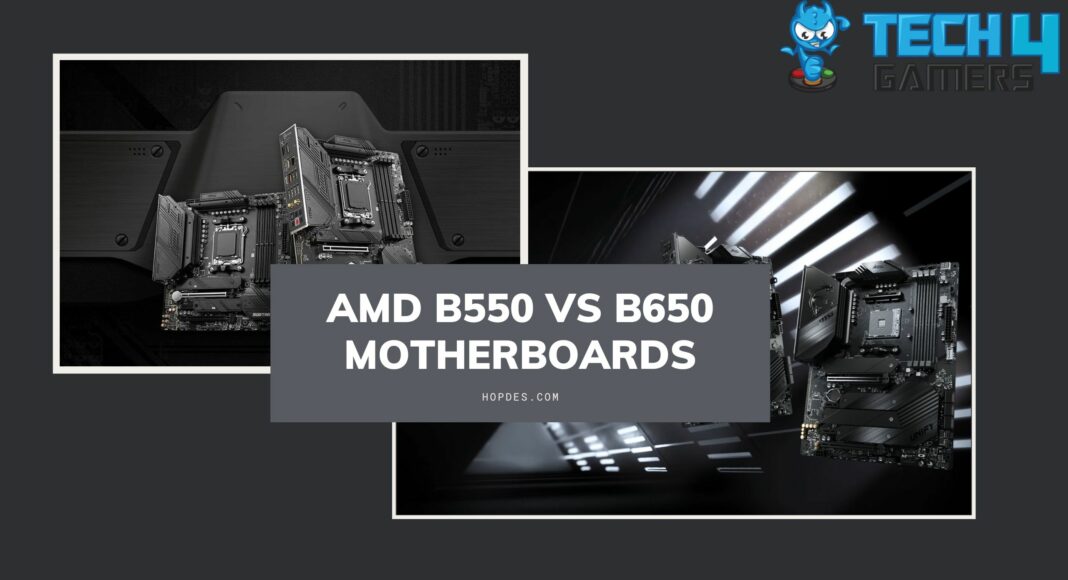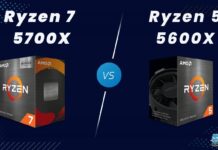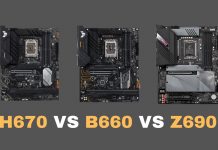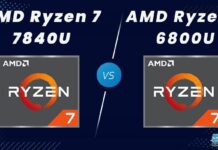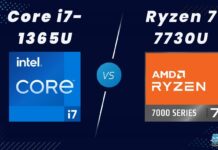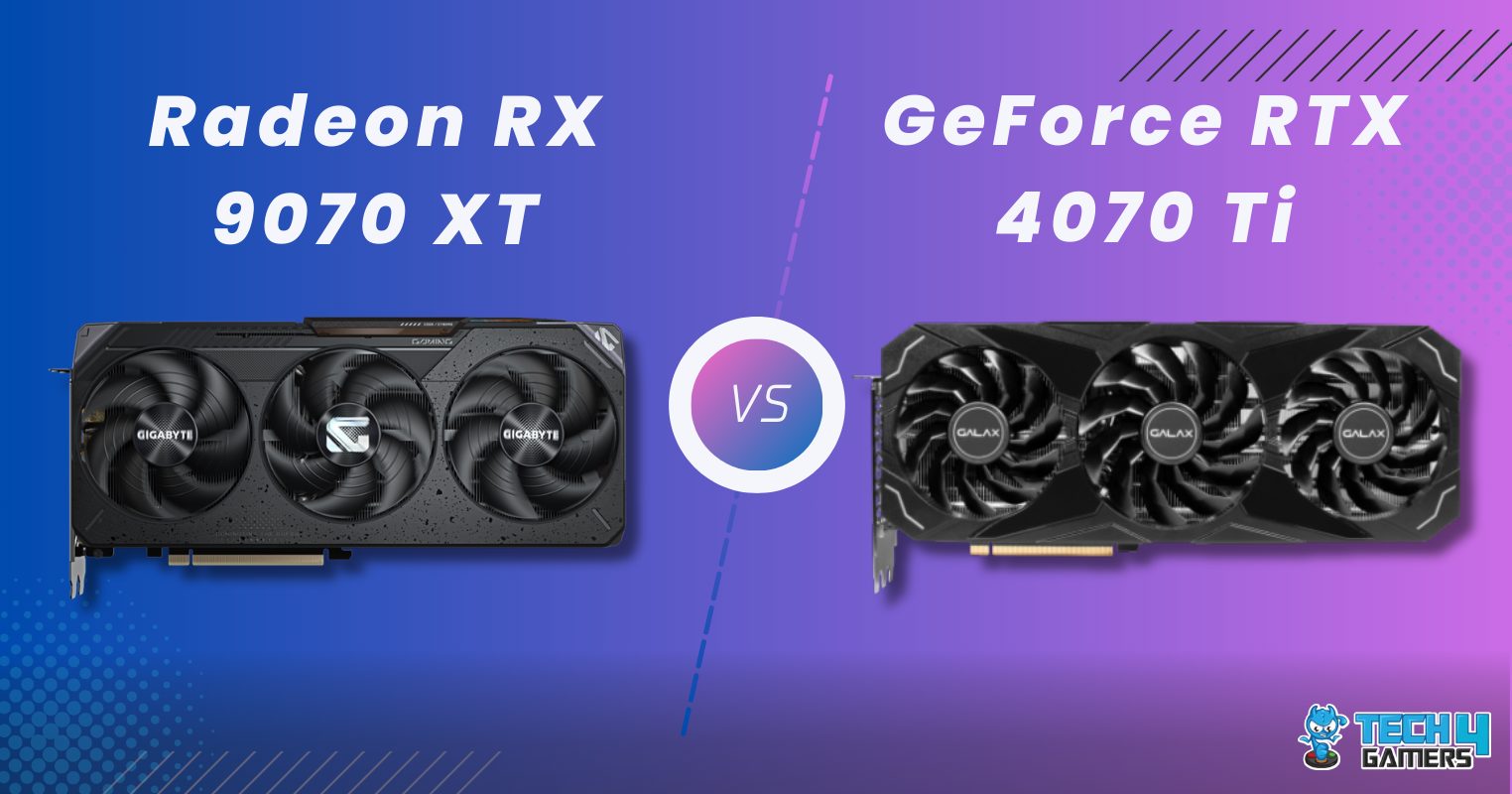AMD B550
Rated: 7.5/10
AMD B650
Rated: 8/10
Pros And Cons
| Motherboard | Pros | Cons |
|---|---|---|
| AMD B550 | ✅ Cost-effective option compared to B650 ✅ Reliable support for older Ryzen CPUs (3000/5000 series) | ❌Limited PCIe 4.0 lanes ❌Fewer M.2 slots and SATA ports |
| AMD B650 | ✅ Future-proofing with support for upcoming Ryzen CPUs ✅Greater number of M.2 slots and SATA ports | ❌Very high price ❌Overkill for users with older Ryzen CPUs |
- Both the B550 and B650 are AMD’s mainstream chipsets for their Ryzen lineup.
- Regarding CPU support, the B650 chipset supports AMD’s Ryzen 7000 series (and all Ryzen CPUs until 2025), while the B550 chipset is limited to the Ryzen 3000 and Ryzen 5000 CPUs.
- With the upgrade to Ryzen 7000, B650 also supports DDR5 memory and drops DDR4 support. B550, on the other hand, only supports DDR4.
- B650 motherboards have support for more I/O than B550, including more M.2 slots.
- As of May 2023, entry-level B550 motherboards cost at least $85, while B650 motherboards start at $125. Premium B550 and B650 options can cost up to $300 or beyond.
The BX50 Chipset Lineup
AMD’s B-series chipset lineup is the mainstream chipset for their Ryzen lineup. This chipset lineup has been the option for most users since it supports (at least) one high-end graphics card and one speedy NVMe SSD. It also supports CPU and memory overclocking. The only “downgrade” compared to the enthusiast “XX70” lineup is less bandwidth and, consequently, less I/O. However, the amount of I/O is still plenty for the average user.
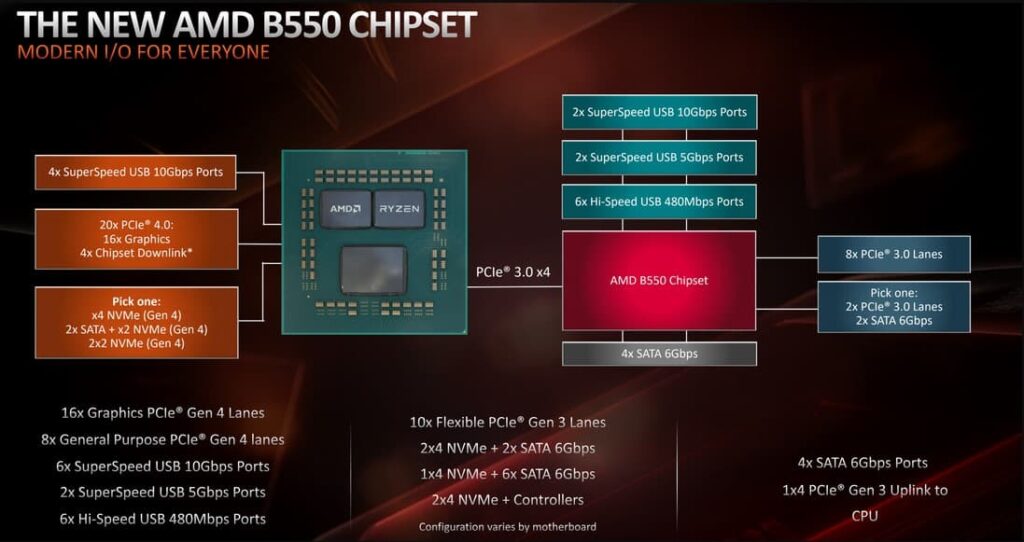
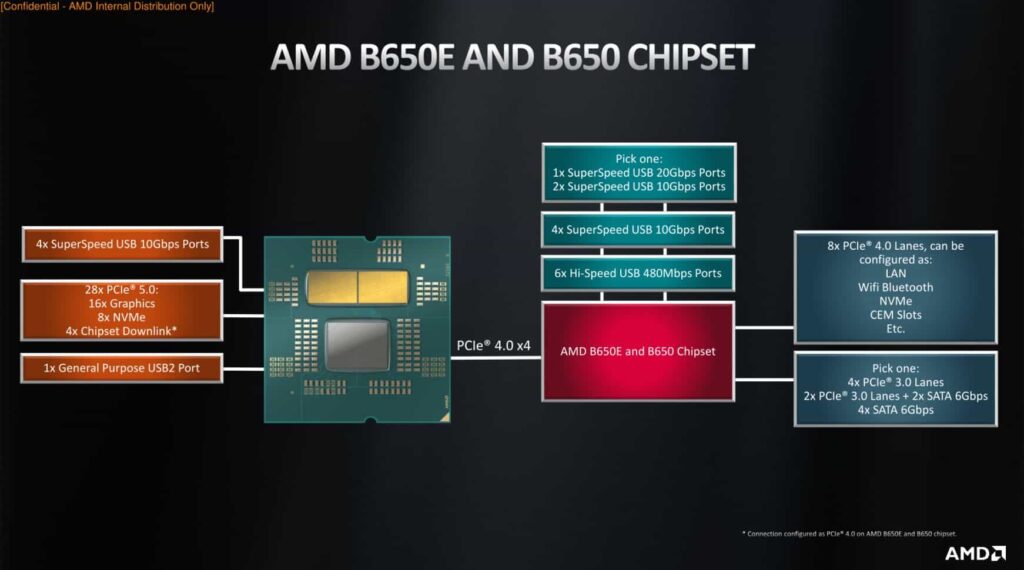
The key difference between B650 and B550 is, of course, the CPU support. With the Ryzen 7000, AMD has moved to a new socket called AM5. As a result, any older chipsets cannot extend support to these AM5 CPUs. Summing up, the B650 chipset supports Ryzen 7000, while the B550 supports Ryzen 3000 and Ryzen 5000 CPUs.
Other than CPU support, the B650 gets the upper hand regarding I/O and memory support, which we will discuss next.
Comparison Table
| Chipset | B650 | B550 |
|---|---|---|
| Socket | AM5(LGA1718) | AM4 (PGA1331) |
| Supporting Lineups | Ryzen 7000 Series | Ryzen 3000 Series Ryzen 5000 Series |
| CPU Overclocking | Yes | Yes |
| Memory Support | DDR5(Up to 6400 MT/s) | DDR4 (Up to 5400 MT/s) |
| No. of DIMMS per Channel | 2 | 2 |
| Memory Overclocking | Yes | Yes |
| Chipset Link | PCIe 3.0 x4 | PCIe 4.0 x4 |
| Total No. of USB Ports | Up to 16 | Up to 12 |
| No. of USB 3.2 (20 Gb/s) Ports | Up to 1 | N/A |
| No. of USB 3.2 (10 Gb/s) Ports | Up to 10 | Up to 6 |
| No. of USB 3.2 (5 Gb/s) Ports | Up to 10 | Up to 2 |
| No. of USB 2.0 Ports | Up to 7 | Up to 6 |
| SATA 3.0 (6.0 Gb/s) Ports | Up to 4 | Up to 6 |
| Wi-Fi Support | Wi-Fi 6/ Wi-Fi 6E | Wi-Fi 6/ Wi-Fi 6E |
| Launch Date | Oct 4th, 2022 | Jun 16th, 2020 |
| Best Motherboards | Best B650 Motherboards | Best B550 Motherboards |
AMD’s B650 chipset is the new mainstream option for those looking to rock their new Ryzen 7000 CPUs. With this chipset following the same naming pattern and succeeding B550, what else has changed besides the CPU support? Let’s find out today as we compare AMD B550 vs B650.
Socket Design
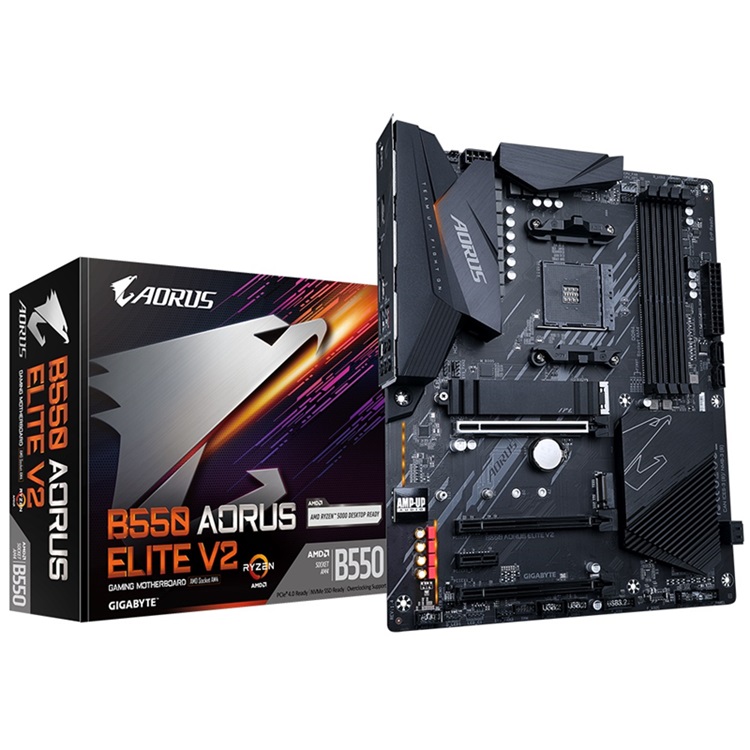
B650 motherboards use the new LGA1718 socket for AMD Ryzen 7000 CPUs, while B550 boards stick to the older AM4 PGA socket. LGA sockets have pins on the CPU, offering higher pin density than PGA sockets on the motherboard. The comparison of AM5 vs AM4 sockets further details their differences.
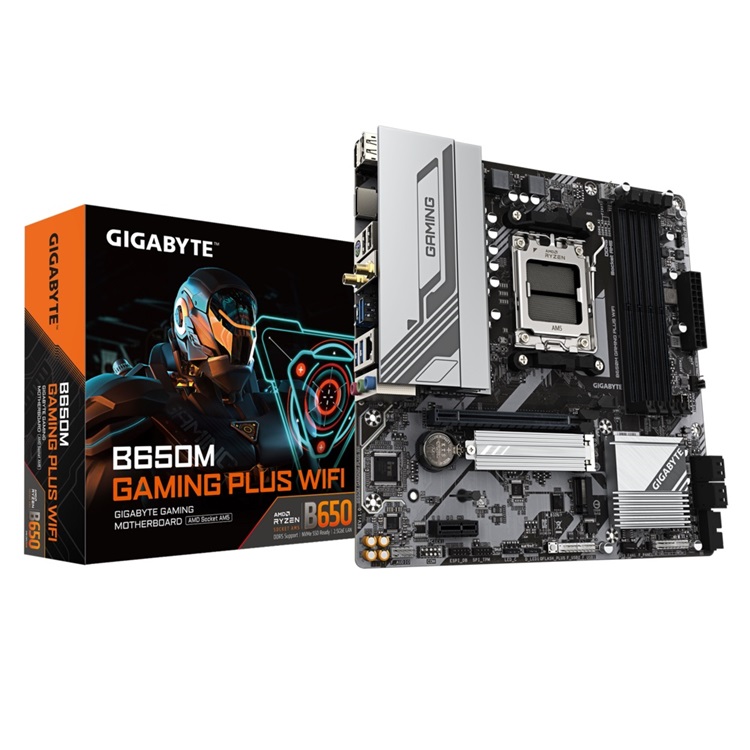
CPU Support
B650 chipset supports Ryzen 7000 CPUs and is slated to support upcoming CPUs until 2025, potentially including Ryzen 8000 and Ryzen 9000. Meanwhile, the B550 chipset is limited to the Ryzen 3000 and Ryzen 5000 series CPUs.
Memory Support
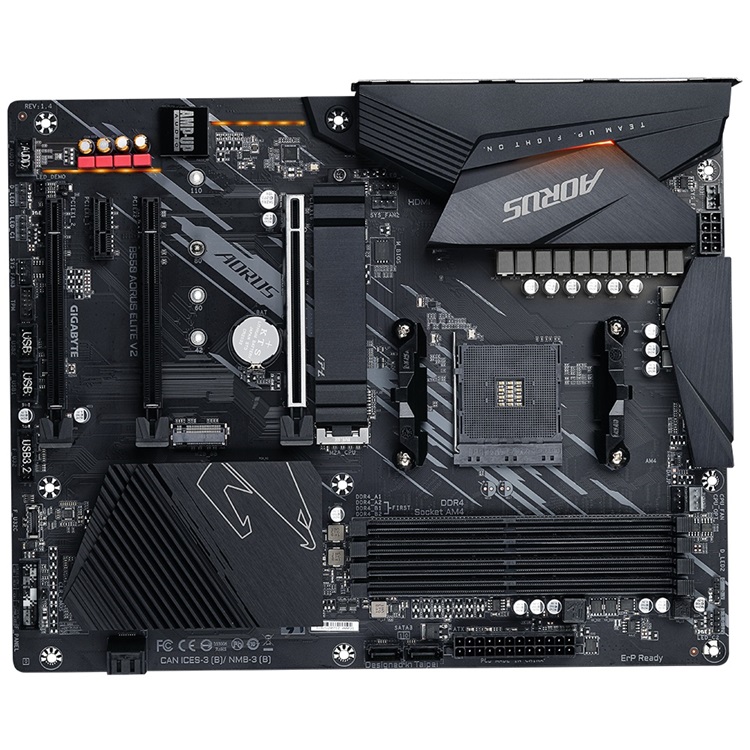
B650 chipset exclusively supports DDR5 RAM with speeds up to 6400 MT/s, accommodating 4 DIMMs (2 per channel). In contrast, the B550 chipset supports DDR4 RAM with speeds up to 5400 MT/s, providing reliable performance but lacking the advancements seen in DDR5.
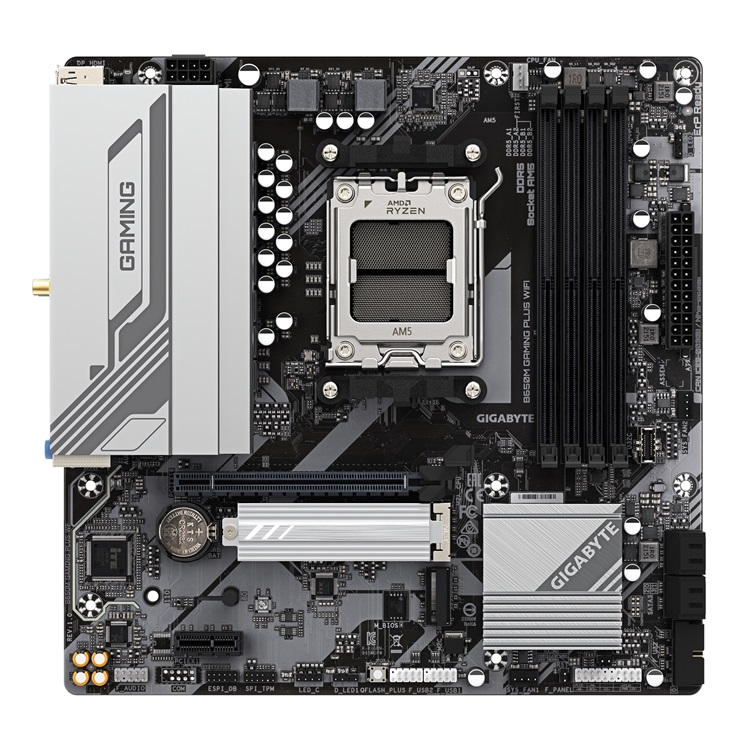
Chipset Link
The B650 chipset features an upgraded CPU-to-chipset link, utilizing PCIe 4.0 x4 connectivity. This advancement provides double the bandwidth for I/O operations compared to the B550 chipset, which utilizes four lanes of PCIe Gen 3. Transitioning to PCIe 4.0 not only enables faster data transfer rates but also enhances performance for peripherals and storage devices.
PCIe Support
B650 chipset enhances PCIe connectivity with 24 lanes of PCIe 5.0 from the CPU (16 for GPUs, 8 for NVMe), alongside 8 lanes of PCIe 4.0 and 4 lanes of PCIe 3.0 from the chipset. In contrast, B550 offers 20 CPU lanes of PCIe 4.0 (16 for GPUs, 4 for NVMe/SATA) and supports up to 10 PCIe 3.0 chipset lanes.
USB Ports
B650 chipset offers up to 16 USB ports, including 1 USB 3.2 20 Gb/s, 10 USB 3.1 10 Gb/s, and 7 USB 2.0 ports. In contrast, B550 supports up to 12 ports, including 6 USB 3.2 10 Gb/s, 2 USB 3.2 5 Gb/s, and 6 USB 2.0 ports, lacking USB 3.2 20 Gb/s support.
SATA 3.0 Ports

A notable difference between the B650 and B550 chipsets is in SATA 3.0 port support. B650 boards offer 4 ports, while B550 can handle up to 6, albeit sacrificing 2 PCIe lanes for the latter. This discrepancy affects storage expansion choices for users considering these motherboards.
M.2 Slots
B650 offers superior M.2 slot support compared to B550. It includes three PCIe 4.0 x4 M.2 slots from the chipset, along with an additional PCIe 4.0/5.0 x4 slot and 4 PCIe Gen 3 lanes. In contrast, B550 provides two PCIe 3.0 x4 M.2 slots and gains two PCIe 3.0 lanes, but this enhancement requires sacrificing two SATA 3.0 ports.
Thermal Design Power
Regarding power the chipset consumes, the B650 has a slightly higher rating at 7 watts. In comparison, the B550 chipset draws 5 watts of power at most. While the disparity in TDP between the two chipsets is relatively modest, it can still influence considerations such as overall power consumption.
Price And Value
| Motherboards | MSRP | Current Price |
|---|---|---|
| AMD B550 | 💲115 | 💲100 |
| AMD B650 | 💲199 | 💲169 |
| Difference | 72.17% | 69% |
Overall, the B550 is a pretty affordable option for those looking to run a Ryzen 3000 or Ryzen 5000 CPU. However, if you plan to step into Ryzen 9 territory, it will be best not to cheap out on the motherboard; be sure to get a motherboard with decent VRMs.
Which One Should You Get
B550: If you plan to use older Ryzen chips like the Ryzen 3000 or Ryzen 5000 series, the B550 chipset offers reliable support. It’s suitable for users who prioritize compatibility with existing Ryzen CPUs. However, its I/O capabilities are somewhat limited compared to the B650.
B650: For users aiming for future-proofing and compatibility with upcoming Ryzen CPUs, the B650 chipset is the way to go. With support for newer Ryzen 7000 series CPUs and advanced I/O features, the B650 ensures longevity and performance enhancements.
In conclusion, choosing between B550 and B650 primarily depends on your CPU preference and future upgrade plans. B650 stands out with its superior I/O support, accommodating more M.2 slots, SATA 3 ports, and USB ports. If you’re eyeing Ryzen 7000 CPUs or seeking advanced features, the B650 is the logical choice.
Frequently Asked Questions
As of May 2023, B550 motherboards start at $85, while entry-level B650 motherboards cost at least $125. So there’s a fairly significant difference in their prices.
Both the B650 and B550 motherboards are enabled for CPU and memory overclocking. Also, they both (depending on the motherboard) support dual GPUs.
The B650 chipset supports DDR5 memory, making it more future-proof. It will also support all Ryzen CPUs until 2025, as promised by AMD, adding to that future-proofing value.
Thank you! Please share your positive feedback. 🔋
How could we improve this post? Please Help us. 😔
[Hardware Reviewer]
Hi! I’m Ali Tauseef, and I have been writing for Tech4Gamers since 2022. I love all things computer hardware but am particularly fond of CPUs and motherboards, and I like to stay up-to-date about the latest advancements in these worlds, and when possible, write about it. When I’m not doing that, I like to get into a little FPS action in CS2 or get lost in the vast world of RDR2.
Get In Touch: ali@tech4gamers.com


